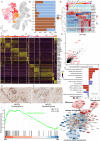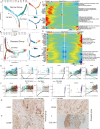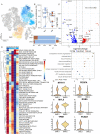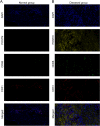Single-cell and spatial transcriptomics reveal changes in cell heterogeneity during progression of human tendinopathy
- PMID: 37280595
- PMCID: PMC10246392
- DOI: 10.1186/s12915-023-01613-2
Single-cell and spatial transcriptomics reveal changes in cell heterogeneity during progression of human tendinopathy
Abstract
Background: Musculoskeletal tissue degeneration impairs the life quality and motor function of many people, especially seniors and athletes. Tendinopathy is one of the most common diseases associated with musculoskeletal tissue degeneration, representing a major global healthcare burden that affects both athletes and the general population, with the clinical presentation of long-term recurring chronic pain and decreased tolerance to activity. The cellular and molecular mechanisms at the basis of the disease process remain elusive. Here, we use a single-cell and spatial RNA sequencing approach to provide a further understanding of cellular heterogeneity and molecular mechanisms underlying tendinopathy progression.
Results: To explore the changes in tendon homeostasis during the tendinopathy process, we built a cell atlas of healthy and diseased human tendons using single-cell RNA sequencing of approximately 35,000 cells and explored the variations of cell subtypes' spatial distributions using spatial RNA sequencing. We identified and localized different tenocyte subpopulations in normal and lesioned tendons, found different differentiation trajectories of tendon stem/progenitor cells in normal/diseased tendons, and revealed the spatial location relationship between stromal cells and diseased tenocytes. We deciphered the progression of tendinopathy at a single-cell level, which is characterized by inflammatory infiltration, followed by chondrogenesis and finally endochondral ossification. We found diseased tissue-specific endothelial cell subsets and macrophages as potential therapeutic targets.
Conclusions: This cell atlas provides the molecular foundation for investigating how tendon cell identities, biochemical functions, and interactions contributed to the tendinopathy process. The discoveries revealed the pathogenesis of tendinopathy at single-cell and spatial levels, which is characterized by inflammatory infiltration, followed by chondrogenesis, and finally endochondral ossification. Our results provide new insights into the control of tendinopathy and potential clues to developing novel diagnostic and therapeutic strategies.
Keywords: Heterotopic ossification; Single-cell RNA-seq; Spatial RNA-seq; Tendinopathy.
© 2023. The Author(s).
Conflict of interest statement
The authors declare that they have no competing interests.
Figures









Similar articles
-
A single-cell atlas depicting the cellular and molecular features in human anterior cruciate ligamental degeneration: A single cell combined spatial transcriptomics study.Elife. 2023 Nov 16;12:e85700. doi: 10.7554/eLife.85700. Elife. 2023. PMID: 37970848 Free PMC article.
-
Overexpression of mechanical sensitive miR-337-3p alleviates ectopic ossification in rat tendinopathy model via targeting IRS1 and Nox4 of tendon-derived stem cells.J Mol Cell Biol. 2020 May 18;12(4):305-317. doi: 10.1093/jmcb/mjz030. J Mol Cell Biol. 2020. PMID: 31065679 Free PMC article.
-
Single-cell transcriptomic profiling reveals distinct mechanical responses between normal and diseased tendon progenitor cells.Cell Rep Med. 2021 Jul 21;2(7):100343. doi: 10.1016/j.xcrm.2021.100343. eCollection 2021 Jul 20. Cell Rep Med. 2021. PMID: 34337559 Free PMC article.
-
What understanding tendon cell differentiation can teach us about pathological tendon ossification.Histol Histopathol. 2015 Aug;30(8):901-10. doi: 10.14670/HH-11-614. Epub 2015 Apr 8. Histol Histopathol. 2015. PMID: 25851144 Review.
-
A systematic review of inflammatory cells and markers in human tendinopathy.BMC Musculoskelet Disord. 2020 Feb 6;21(1):78. doi: 10.1186/s12891-020-3094-y. BMC Musculoskelet Disord. 2020. PMID: 32028937 Free PMC article.
Cited by
-
Limb connective tissue is organized in a continuum of promiscuous fibroblast identities during development.iScience. 2024 Jun 19;27(7):110305. doi: 10.1016/j.isci.2024.110305. eCollection 2024 Jul 19. iScience. 2024. PMID: 39050702 Free PMC article.
-
Transcriptomics reveals dynamic changes in the "gene profiles" of rat supraspinatus tendon at three different time points after diabetes induction.BMC Med Genomics. 2024 May 6;17(1):122. doi: 10.1186/s12920-024-01899-3. BMC Med Genomics. 2024. PMID: 38711057 Free PMC article.
-
A roadmap for delivering a human musculoskeletal cell atlas.Nat Rev Rheumatol. 2023 Nov;19(11):738-752. doi: 10.1038/s41584-023-01031-2. Epub 2023 Oct 5. Nat Rev Rheumatol. 2023. PMID: 37798481 Review.
-
Identification of age-related genes in rotator cuff tendon.Bone Joint Res. 2024 Sep 10;13(9):474-484. doi: 10.1302/2046-3758.139.BJR-2023-0398.R1. Bone Joint Res. 2024. PMID: 39253760 Free PMC article.
-
A distribution-free and analytic method for power and sample size calculation in single-cell differential expression.Bioinformatics. 2024 Sep 2;40(9):btae540. doi: 10.1093/bioinformatics/btae540. Bioinformatics. 2024. PMID: 39231036 Free PMC article.
References
Publication types
MeSH terms
LinkOut - more resources
Full Text Sources
Medical

